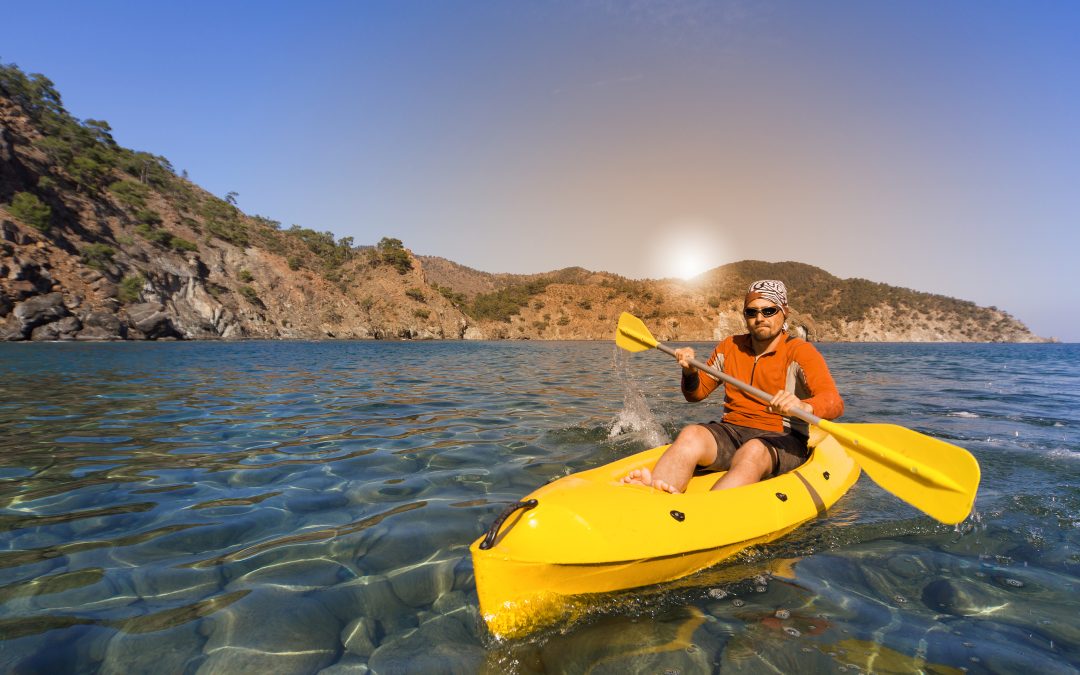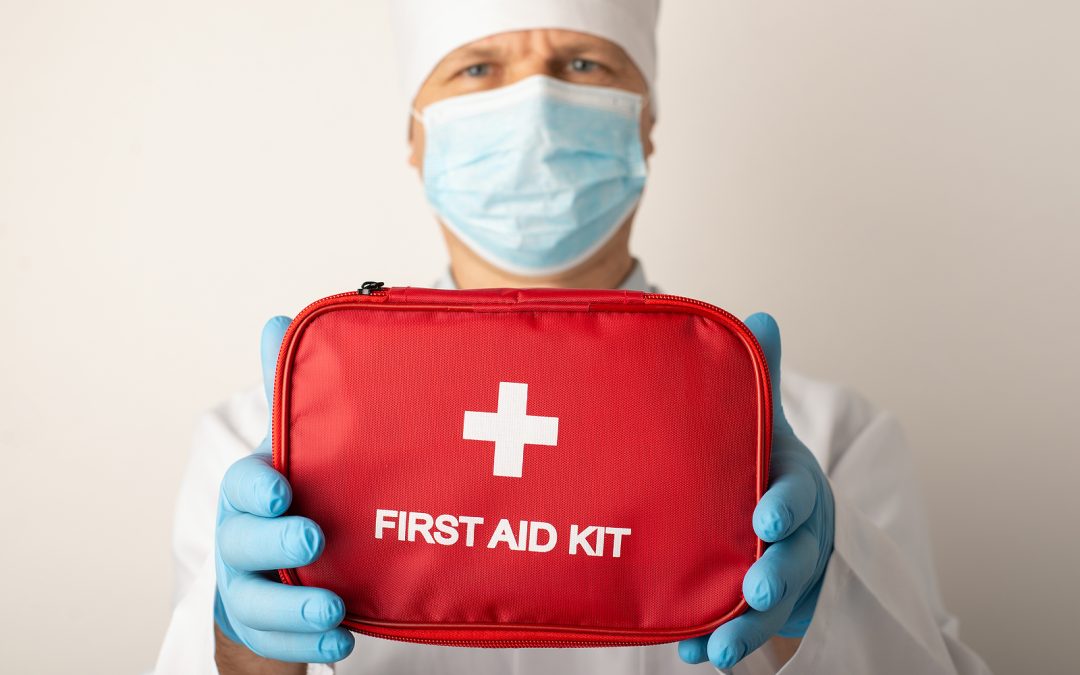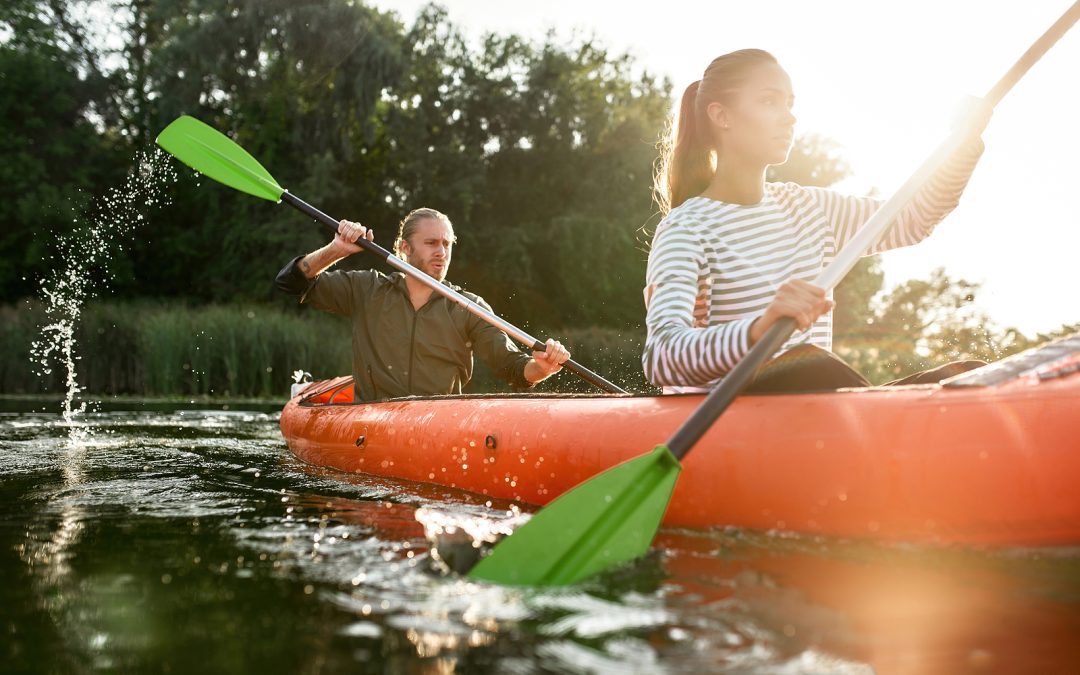Kayaking offers a fantastic way for fitness enthusiasts to improve their physical health while enjoying the outdoors and engaging in exciting adventures. As a full-body workout, it targets several muscle groups, enhancing cardiovascular health and muscle strength. Moreover, the sport complements other fitness activities, such as running, as it emphasizes upper body conditioning and puts less stress on joints.
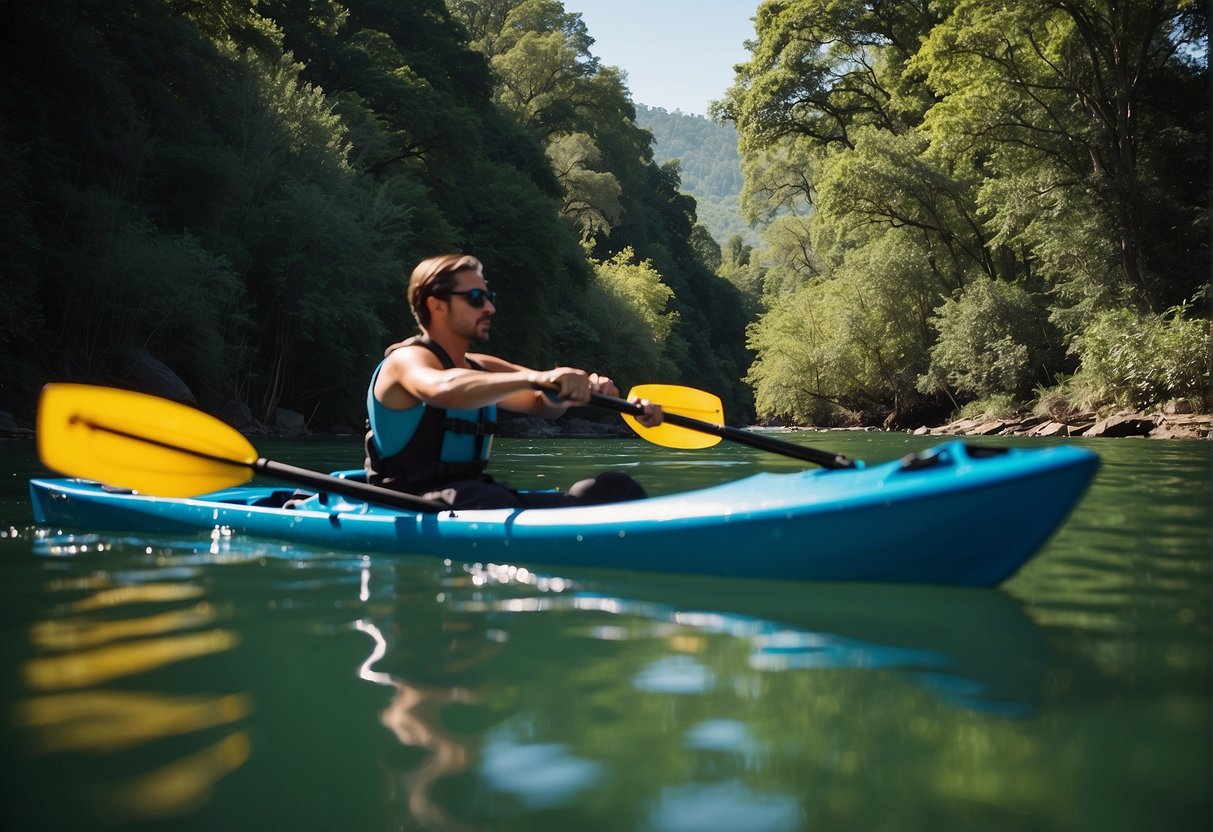
One of the main benefits of kayaking is its ability to improve cardiovascular health through consistent, heart-pumping movement. In addition, it helps build upper body strength by working on your core, back, shoulders, and arms during the repetitive paddling motion. Furthermore, kayaking offers opportunities for cross-training and weight loss, making it a comprehensive workout for individuals of different fitness levels.
Key Takeaways
- Kayaking is a full-body workout that enhances cardiovascular health and muscle strength.
- The sport mainly benefits core stability and upper body conditioning.
- Cross-training and weight loss are benefits of making kayaking part of a fitness routine.
The Basics of Kayaking
Kayaking is a popular and enjoyable water sport that benefits fitness enthusiasts. This low-impact activity works on upper body muscles, improving strength and endurance. In addition, kayaking can help improve balance and coordination skills. To start kayaking, it’s essential to understand the basics, such as paddle strokes, balance, and control.
First and foremost, selecting the right kayak and paddle is crucial for an enjoyable experience. There are various types of kayaks, such as sit-on-top, recreational, and touring kayaks. Choosing the appropriate type depends on the paddler’s goals and preferred body of water. Paddles, too, come in different materials and sizes. Selecting a paddle that suits the paddler’s height and arm length is essential.
When it comes to paddling, there are several foundational strokes every beginner should learn:
- Forward stroke: The most common stroke used to propel the kayak forward.
- Reverse stroke: Performed in the opposite direction as a bold stroke, this stroke helps slow down or move backward.
- Sweep stroke: Essential for turning the kayak, this stroke is executed by sweeping the paddle in a wide arc.
Developing proficiency in these strokes allows kayakers to move efficiently and safely in the water.
Balance is a critical aspect of kayaking. A stable kayak offers a more enjoyable experience and reduces the risk of capsizing. To achieve proper balance, the paddler should sit upright, maintain a relaxed posture, and keep their center of gravity low. Engaging the core muscles and keeping a firm grip on the paddle also contribute to better balance.
Control is a vital skill to master in kayaking. Steering and maneuvering the kayak require the paddler to use body movement and paddle strokes effectively. Leaning slightly in the direction of the turn and mastering the sweep stroke help maintain control over the kayak’s direction. Practicing different strokes and their variations enables paddlers to navigate more challenging scenarios and conditions.
In summary, grasping the basics of kayaking, such as paddle strokes, balance, and control, is essential for fitness enthusiasts looking to incorporate this low-impact activity into their exercise routine. As with any sport, consistent practice and proper technique are vital to improving skill and enjoying a safe and rewarding kayaking experience.
Kayaking for Cardiovascular Health
Kayaking is an excellent form of cardio exercise with numerous cardiovascular health benefits. When paddling, the motion increases your heart rate and helps improve blood circulation, leading to better oxygenation of the muscles and organs.
The continuous rhythmic motion of paddling works the upper body muscles, such as the arms, shoulders, and back, while engaging the core and lower body to maintain balance. This full-body workout provides a well-rounded way to build and maintain a strong heart and improve overall endurance.
One of the reasons for kayaking’s popularity among fitness enthusiasts is its low-impact nature. Kayaking allows you to engage in an effective cardiovascular workout without putting excessive stress on your joints, making it an excellent alternative for those who experience discomfort during high-impact exercises like running.
In addition to improving cardiovascular health, regular kayaking sessions can also contribute to increased endurance and performance in other sports. With every kayaking session, your body adapts to the workout demands and becomes more efficient in supplying oxygen and nutrients to your muscles, reducing fatigue, and boosting your overall stamina. This increased endurance can translate to more sustained energy in various athletic and daily activities.
To make the most of your kayaking workouts, consider incorporating interval training techniques such as alternating between faster, more intense periods of paddling followed by gentler, slower recovery phases. This method can maximize the cardiovascular benefits while improving muscle strength and endurance.
In summary, kayaking is an enjoyable yet challenging cardio exercise that positively impacts cardiovascular health, endurance, and performance. Its low-impact nature and full-body engagement make it an appealing choice for fitness enthusiasts seeking a versatile and refreshing way to improve their overall well-being.
Strength Training for Kayakers
Strength training is essential for kayakers looking to improve their paddling performance and prevent injuries. A well-designed program can help paddlers develop the necessary muscles and endurance to tackle longer, more challenging routes.
The primary muscle groups in kayaking include the back, shoulders, arms, and core. Incorporating exercises targeting these muscles can lead to increased power and stability while paddling. A few critical exercises for kayakers are:
- Pull-ups: This exercise primarily targets the upper back and shoulders, crucial for effective paddling.
- Seated cable rows strengthen the mid-back and latissimus dorsi muscles, improving overall pulling power.
- Push-ups: An essential exercise for kayakers, push-ups target the chest, triceps, and shoulders, contributing to a balanced upper body strength.
- Plank variations: A strong core is necessary for maintaining balance and stability in the kayak. Plank exercises, including side and reverse planks, build core strength.
It is crucial to focus not only on building muscle but also on training for endurance. Paddling for extended periods requires muscles that can withstand repetitive motions. Higher repetition ranges (12-15 reps) and lower weights will train the muscles to resist fatigue.
In addition to the exercises mentioned above, it is advisable to focus on overall fitness by implementing cardiovascular and flexibility training into a kayaker’s routine. These elements help enhance endurance, improve recovery, and maintain mobility while on the water.
For optimal results, a kayaker should aim to strength train at least 2-3 times weekly. Keeping this consistent schedule allows the muscles to develop and adapt to the rigors of kayaking. Kayakers can significantly enhance their overall performance and enjoyment on the water by integrating strength training, cardio, and flexibility exercises.
Core Stability and Kayaking
In kayaking, having a solid and stable core is essential for efficient and powerful paddling. The core muscles, which include the abdominals, obliques, and lower back muscles, play a crucial role in providing power and stability while paddling. They also help maintain proper posture and reduce the risk of injuries.
A strong core is essential for torso rotation, allowing the kayaker to generate force and power while paddling. A well-trained core also improves joint stability and ligament and tendon strength, making the paddler more resilient to injury ^1^.
Several specific exercises can help kayakers build their core strength and stability. Incorporating these exercises into a regular workout routine can improve overall kayaking performance:
- Planks: This exercise engages the entire core and other stabilizing muscles. Hold a plank position, with your forearms on the ground and elbows under your shoulders, for 30-60 seconds. Repeat for three sets.
- Bicycle crunches target both the obliques and the rectus abdominis muscles ^2^. Perform three sets of 20 repetitions on each side.
- Side planks: Holding a side plank for 30-45 seconds, working up to three sets, can help develop the obliques and improve core stability ^3^.
- Russian twists: This exercise focuses on torso rotation and the oblique muscles. With your legs bent and feet lightly touching the ground, lean back slightly and twist your torso – bringing a medicine ball from one side to the other. Complete three sets of 15 repetitions.
Including adequate rest and recovery time between core workout sessions is essential. Allowing at least 48 hours of rest between workouts can help ensure proper recovery and adaptation ^4^.
By regularly focusing on developing core strength and stability, kayakers can significantly improve their overall paddling performance and reduce the risk of injury. This increased power and stability will lead to more enjoyable time on the water and more efficient paddling sessions.
Upper Body Conditioning

Kayaking is a fantastic way to achieve a full-body workout, particularly for the upper body. It targets various muscle groups, such as the arms, shoulders, chest, and back, making it an ideal activity for fitness enthusiasts.
The primary muscles engaged during kayaking include the pectorals (chest), trapezius (upper back), latissimus dorsi (mid-back), and deltoids (shoulders). This full range of motion leads to a balanced upper body workout and helps develop muscular endurance. For a more effective workout, proper paddling technique is essential.
When kayaking, make sure to:
- Maintain a relaxed grip on the paddle.
- Rotate your torso for efficient power transfer.
- Keep elbows bent at a 90-degree angle to protect your joints.
- Engage your core muscles for stability.
Incorporating additional strength training exercises can benefit those looking to enhance their upper body conditioning further. Some recommended exercises are:
- Push-ups: Build strength in the chest and triceps.
- Dumbbell rows: Targets the lats and rhomboids in the back.
- Shoulder presses: Works on the deltoids and triceps.
- Pull-ups: Develop the lats, biceps, and trapezius muscles.
Combined with kayaking, these exercises can improve on-water performance and upper-body strength1. Consistency is vital in achieving progress. Implement the exercises in a regular workout routine for optimum results.
In summary, kayaking provides fitness enthusiasts with an excellent, low-impact upper-body workout. Focusing on proper paddling techniques and incorporating supplementary strength training exercises can efficiently condition their arms, shoulders, chest, and back, improving their fitness and kayaking performance.
Footnotes
Lower Body Workouts for Paddling

While kayaking is often considered an upper-body sport, the lower body provides stability and power to each paddling stroke. Integrating lower-body workouts into your fitness routine will enhance paddling performance and overall functionality. Here are a few exercises to consider.
1. Squats: Squats are an excellent way to target the glutes, hamstrings, and quads. Proper squat form involves keeping your feet shoulder-width apart and lowering your hips like sitting in a chair. Maintain a straight back and engage your core throughout the movement. Aim for 3-4 sets of 12-15 repetitions.
2. Lunges: Lunges help improve balance and activate the hip flexors, essential for efficient paddling. To perform, step forward with one foot and lower your hips until both knees are bent at a 90-degree angle. Then, push back up and repeat with the other leg. Complete 3-4 sets of 10-12 repetitions on each leg.
3. Deadlifts: Deadlifts strengthen the lower back, glutes, and hamstrings, contributing to a solid paddling foundation. With feet hip-width apart and a slight bend in your knees, push your hips back and pick up a barbell or dumbbell. Maintain a straight back, engage your core, and lift the weight by pushing your hips forward. Perform 3-4 sets of 8-10 repetitions.
4. Hip Bridges: To target the glutes, hamstrings, and lower back, lie on your back with your feet flat on the floor and knees bent. Lift your hips, forming a straight line from your shoulders to your knees. Hold this position for a few seconds before lowering back down. Complete 3-4 sets of 12-15 repetitions.
5. Leg Raises: Leg raises engage the hip flexors, which play a vital role in stabilizing the torso during paddling. Lie on your back with your legs straight and hands at your sides. Lift your legs off the ground until they reach a 90-degree angle, and lower them slowly without touching the floor. Perform 3-4 sets of 10-12 repetitions.
Incorporating these lower-body workouts into your fitness regime will enhance your kayaking performance, help prevent injuries, and improve overall strength. Remember to modify the workouts according to your fitness level and maintain proper form during each exercise.
Muscle-Specific Exercises for Kayakers
Kayaking is a fantastic total-body workout that incorporates a wide range of muscle groups. One of the critical elements of kayaking fitness is focusing on muscle-specific exercises that target the key muscle groups used during paddling. This section will discuss some practical exercises for the abdominals, lats, biceps, forearms, and latissimus dorsi.
Abdominals: A strong core is essential for efficient paddling and maintaining balance on the water. Incorporating exercises like planks and bicycle crunches can help improve core stability and overall kayaking performance. Aim for three sets of 30-45 seconds for planks and three sets of 20 bicycle crunches for each side.
Lats and Latissimus Dorsi: The latissimus dorsi and lats play a crucial role during the paddling motion. Improve the strength and endurance of these muscles by incorporating exercises like pull-ups and rows into your fitness routine. Perform 3-5 sets of 6-10 reps for strength or 3-5 sets of 12-15 reps for endurance.
Biceps: The biceps assist with the pulling motion during each paddle stroke. Strengthen your biceps by including exercises like dumbbell curls and hammer curls. Aim for 3-5 sets of 6-10 reps for strength or 3-5 sets of 12-15 reps for endurance.
Forearms: A firm grip on the paddle is essential for efficient kayaking, prioritizing muscular forearms. Improve your forearm strength with exercises like wrist curls and reverse wrist curls. Perform these exercises for 3-5 sets of 10-15 reps each.
By incorporating these muscle-specific exercises into your fitness routine, you can effectively target key muscle groups used in kayaking and improve your overall performance on the water.
Preventing Kayaking Injuries
Kayaking is an excellent way for fitness enthusiasts to engage in a challenging and fun workout. However, like any other sport, taking precautions and adopting best practices to prevent injuries is crucial. By focusing on proper posture, back support, stretching, and muscle activation, kayakers can reduce their risk of injury and enhance their overall paddling experience.
Proper posture plays a vital role in preventing injuries while kayaking. It is essential to maintain a neutral spine, with the chest slightly lifted and the shoulders relaxed. This position ensures even pressure distribution on the muscles, reducing strain on the lower back and spine. Moreover, engaging the core muscles while paddling helps stabilize the body, minimizing the risk of injuries caused by sudden movements or imbalances.
Back support is equally essential when it comes to preventing kayaking injuries. Adequate support can be achieved by adjusting the seat or backrest, ensuring that it fits snugly against the lower back’s natural curve. This Kayaking Training Guide suggests that a well-supported sitting position alleviates pressure on the spine and encourages better posture during paddling.
Incorporating stretching into your kayaking routine is essential for maintaining flexibility, reducing stiffness, and preventing injuries. It is recommended to perform dynamic stretches before getting into the water, focusing on the major muscle groups such as the hamstrings, quadriceps, shoulders, and lower back. Additionally, Aqua-Bound suggests practicing mobility training to target the hamstrings, as tightness in these muscles can make sitting in a kayak uncomfortable.
Performing muscle activation exercises before kayaking can help prevent injuries by warming up the muscles and increasing blood flow to the area. Examples of muscle activation exercises include shoulder shrugs, ankle pumps, scapular retraction, and bodyweight squats. These exercises help prepare the muscles to handle the physical demands of kayaking better and reduce the risk of strains, sprains, or other common kayaking injuries.
In summary, by prioritizing proper posture, back support, stretching, and muscle activation, fitness enthusiasts can enjoy the benefits of kayaking while minimizing the risk of injuries. By adhering to these preventative measures, kayakers can confidently engage in their sport with the knowledge that they are protecting their bodies and promoting long-term health and well-being.
Advanced Kayaking Techniques
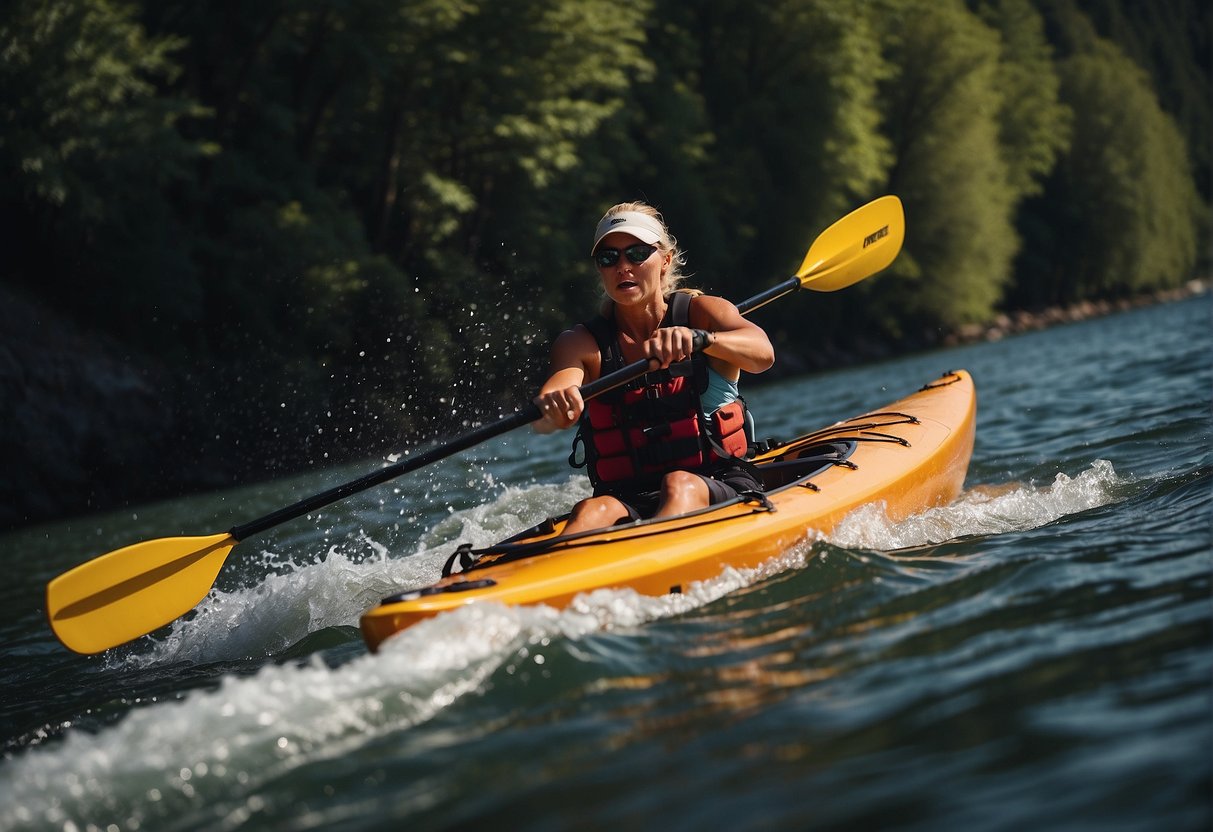
Mastering advanced techniques is essential for fitness enthusiasts looking to improve their kayaking performance and participate in races. These techniques enhance efficiency and help maintain safety on the water.
Regarding kayaking, the key to success is efficient paddling strokes. A smooth, well-executed stroke allows the kayaker to easily navigate obstacles and maneuver the boat. Working on perfecting your paddling technique can make a significant difference in your kayaking experience source.
In terms of advanced techniques, one crucial skill to develop is bracing against waves. Understanding how to brace allows a kayaker to maintain stability and control in challenging conditions. Additionally, navigating tidal currents, comprehending wind and weather patterns, and practicing effective communication are vital in advanced sea kayaking.
Another essential component for advanced kayakers is kayak rolling techniques. These techniques serve as an invaluable self-rescue method, allowing the kayaker to quickly reorient themselves after capsizing without exiting the boat. Learning and practicing different rolling techniques will increase safety during long paddling sessions or races source.
For those interested in competitive kayaking, developing endurance is necessary. A structured kayak training program can help improve fitness levels and increase stamina for demanding races. The program should include intervals of hard paddling, alternating with periods of moderate-paced, conversational paddling.
In conclusion, focusing on advanced kayaking techniques such as effective paddling strokes, bracing against waves, understanding weather conditions, and developing physical endurance will ensure better performance in races and a more enjoyable experience for fitness enthusiasts.
Creating a Balanced Kayaking Training Plan
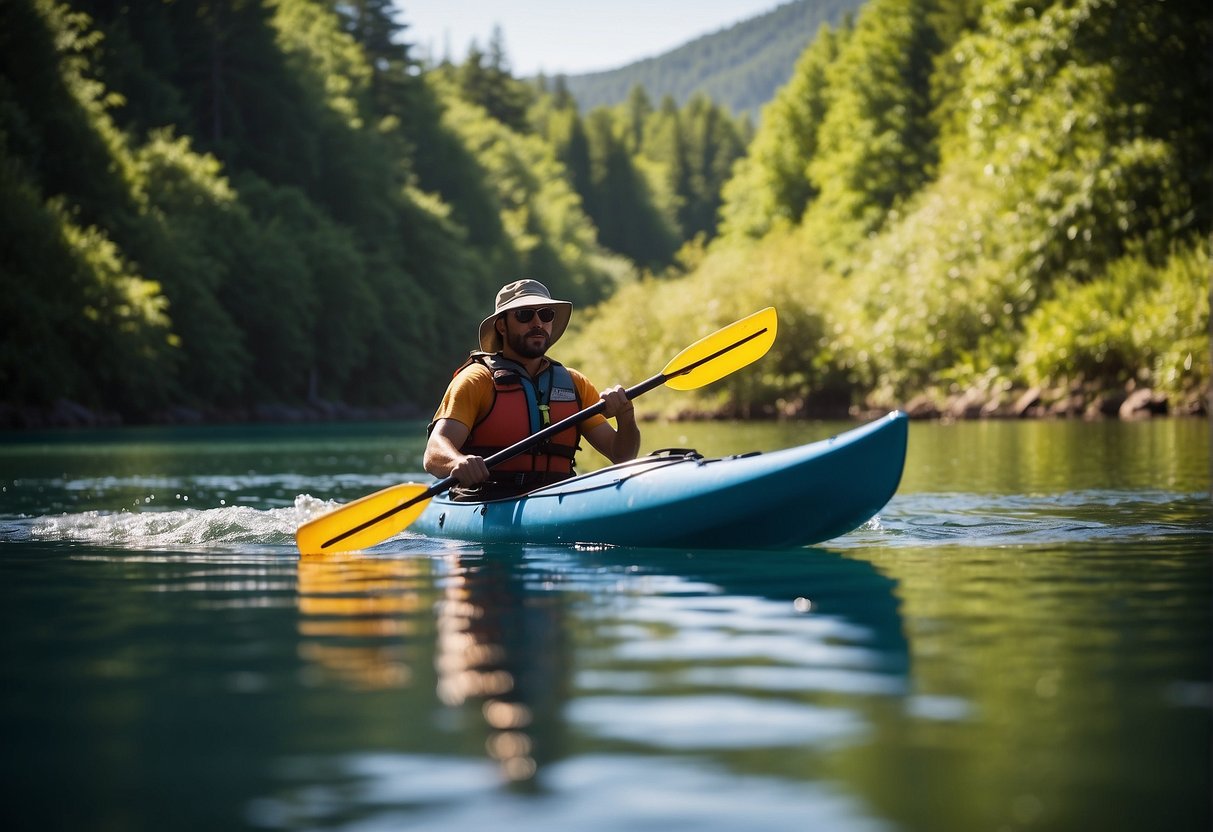
A well-rounded kayaking training plan involves a mix of on-water sessions and off-water exercises. By incorporating various elements like strength training, cardiovascular conditioning, and flexibility, paddlers can enhance their overall performance and reduce the risk of injuries. This section will discuss the main components of a balanced kayaking training program.
Strength training is essential for building power and endurance in kayaking. The primary muscles include the shoulders, back, arms, and core. Some practical strength training exercises for kayakers are kettlebell swings, pull-ups, lunges, and push-ups. Maintaining proper form and consistency while performing these exercises is crucial to avoid strain and injury. Aim for 2 to 3 sessions per week, with rest days in between to allow muscles to recover.
Cardiovascular training is another critical part of a kayaking training plan. It helps improve overall fitness, stamina, and paddle efficiency. To maintain aerobic capacity, engage in activities like running, swimming, or cycling at least 2-3 times a week. On-water training is the best option to target the skills needed for kayaking directly and should be incorporated into the weekly routine.
Flexibility and mobility also play essential roles in kayaking performance. Kayakers should include stretching exercises targeting the ankles, hips, and upper body to enhance mobility and prevent soreness or injuries. Yoga, pilates, or dynamic stretching can be integrated into the training plan for improved flexibility.
To create a balanced kayaking training plan, consider incorporating these components:
- Strength training: 2-3 sessions per week
- Cardiovascular training: 2-3 sessions per week
- On-water training: 1-2 sessions per week
- Flexibility/mobility training: 2-3 sessions per week
Remember to tailor the program to personal fitness levels and kayaking goals. Adjust the intensity and frequency as needed, and seek guidance from coaches or experienced kayakers for optimal results.
Kayaking Equipment and Gear

Kayaking can be an excellent workout for fitness enthusiasts, combining cardiovascular activities with upper-body strength training. You’ll need the right equipment and gear to get the most out of your kayaking experience. This section’ll discuss the essentials for a successful kayaking workout, including boats, paddle sports equipment, and complementary exercises incorporating resistance bands, dumbbells, and barbells.
When choosing a boat for kayaking, consider the type of water you’ll be kayaking in, your skill level, and your fitness goals. The Eddyline Skylark Kayak, for instance, is a versatile choice made from lightweight carbon-lite ABS plastic. This boat is suitable for both beginners and experienced paddlers.
For paddle sport enthusiasts, selecting the right paddle is equally essential. Numerous types of paddles are available on the market, ranging from entry-level models to performance-oriented ones. A well-balanced paddle will help you optimize your strokes and conserve energy during your workout.
Besides boats and paddles, having the right personal gear is vital for a comfortable and safe kayaking experience. Essential items include a personal flotation device (PFD), a helmet, water shoes, and appropriate clothing that protects you from the elements.
In addition to the primary kayaking gear, incorporating complementary exercises focusing on different muscle groups can significantly improve your overall fitness. For instance, using a resistance band during your warm-up routine can help engage your core and prepare your upper body for the paddling motion.
Kayaking for Weight Loss
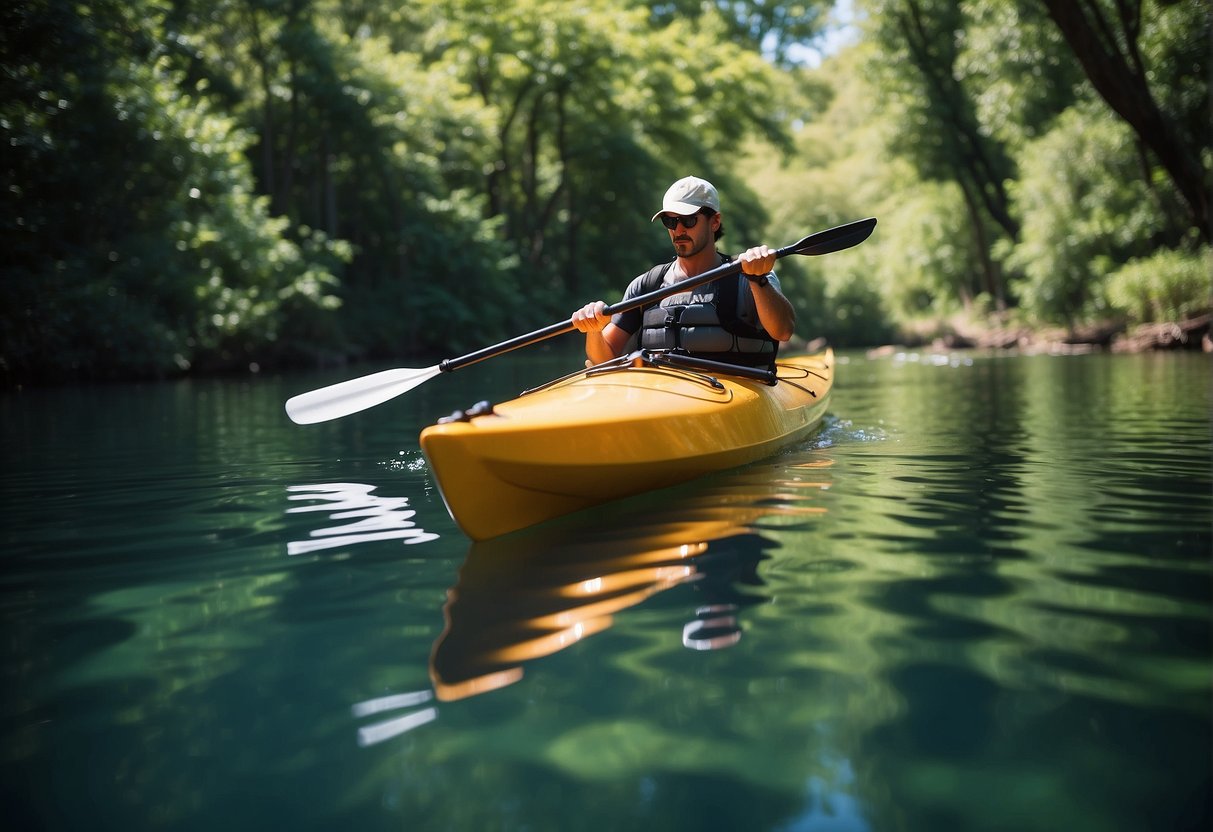
Kayaking is a fantastic full-body workout that can help you achieve your weight loss goals while having fun and exploring the great outdoors. This engaging physical activity allows you to burn calories, develop muscular strength, and improve cardiovascular endurance.
A typical kayaking session can help you burn between 375 and 475 calories per hour depending on your weight, age, and the effort you put into paddling. This makes it an efficient exercise for individuals looking to lose weight. Besides burning calories, kayaking works various muscle groups, including your core, back, shoulders, and arms, contributing to a well-rounded fitness routine.
One of the many benefits of kayaking as a form of exercise is its low-impact nature. Unlike running or other high-impact activities, kayaking is gentle on your joints and can make an excellent addition to your fitness regimen. Kayaking also reduces stress; being out in nature and on the water can have a calming effect on your mind, which is essential for holistic well-being.
Incorporating kayaking into your weekly fitness routine can be highly beneficial. Here are some tips to help you get started:
- Choose the right kayak – Select a kayak that suits your body size, skill level, and the type of water you plan to paddle on.
- Wear appropriate gear – Ensure you have a comfortable life jacket, proper footwear, and suitable clothing for various weather conditions.
- Plan your route – Familiarize yourself with local waterways and designate a safe kayaking route, considering both distance and difficulty.
- Paddle with proper technique – Learn the correct kayaking methods to maximize the efficiency of your strokes and minimize strain on your body.
- Stay consistent – Aim to kayak regularly; more frequent sessions will lead to more significant weight loss and health benefits.
Integrating kayaking into your fitness routine allows you to enjoy a refreshing and challenging workout that supports your weight loss goals while providing numerous physical and mental health benefits.
Cross-Training for Kayakers
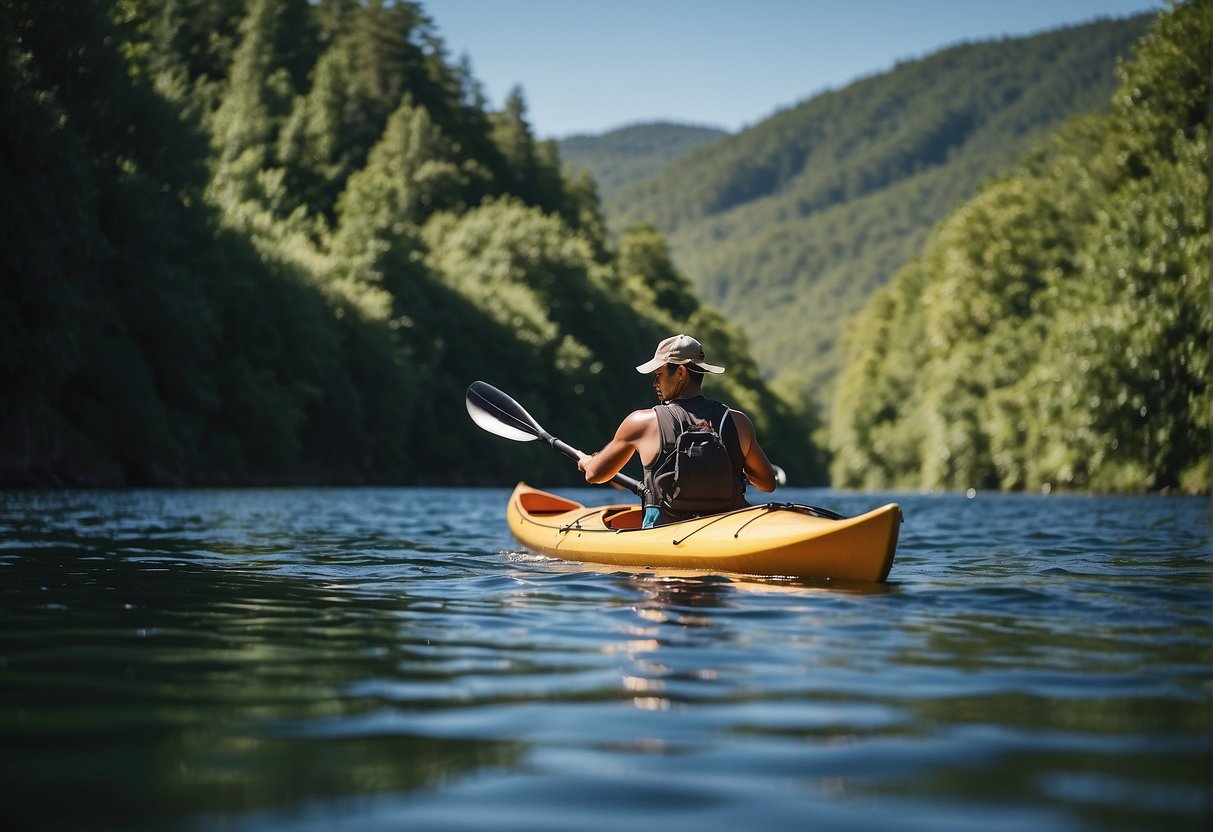
The cross-training benefits kayakers by targeting various muscle groups and incorporating diverse fitness activities. It helps maintain motivation while also enhancing overall performance on the water. Some effective cross-training options for kayakers include biking, jogging, full-body workouts, and aerobic exercise.
Biking is an excellent option for cross-training, as it targets the lower body muscles that often get neglected during kayaking. By strengthening these muscles, kayakers can improve their balance and stability in the boat. Biking also helps increase cardiovascular endurance, translating to better stamina while paddling.
Jogging provides cardiovascular benefits similar to biking but focuses more on the leg muscles, particularly the quadriceps, hamstrings, and calf muscles. By incorporating jogging into their fitness routine, kayakers can enjoy a low-impact aerobic exercise that complements their time on the water.
A full-body workout in a kayaker’s fitness regimen can help target all essential muscle groups. Functional exercises such as planks, push-ups, and squats make excellent additions to a kayaker’s training program. Swimming provides a low-impact, full-body workout that also helps improve core strength and upper-body endurance, essential components for kayaking.
Aerobic exercise is crucial for kayakers looking to increase endurance and stamina for those long paddling trips. One suggestion is to engage in interval training, which combines periods of high-intensity activity with recovery periods. This type of training enhances cardiovascular fitness and can improve a kayaker’s overall paddling efficiency.
In summary, cross-training options such as biking, jogging, full-body workouts, and aerobic exercises help kayakers maintain their fitness and enhance their paddling performance. These activities also prevent boredom and keep motivation high, ensuring kayakers stay prepared for their next adventure on the water.
Kayaking Adventure and Lifestyle
Kayaking offers a unique blend of adventure and lifestyle for fitness enthusiasts seeking an all-around workout. It provides a fun and engaging way to improve physical fitness while enjoying the outdoors. By combining the serenity of nature with the excitement of adventure, kayaking becomes a perfect activity to boost one’s well-being and confidence.
The sport has gained popularity in recent years, particularly among adventure racers. Many adventure races usually involve a kayaking leg. This highlights the sport’s ability to provide a full-body workout and enhance the participant’s sense of adventure.
When it comes to lifestyle, kayaking offers numerous benefits:
- Physical health: Paddling helps develop upper body strength, improves cardiovascular fitness, and increases flexibility. It also provides an excellent workout for the whole body.
- Mental health: Being out on the water and surrounded by nature can calm the mind. This outdoor adventure allows individuals to relax, reduce stress, and boost overall well-being.
- Social opportunity: Kayaking offers a chance to connect with like-minded individuals who share a passion for fitness, adventure, and a healthy lifestyle.
Here are some tips for incorporating kayaking into your fitness routine:
- Choose the right gear: Invest in a suitable kayak, paddle, and safety equipment to ensure a comfortable and secure experience.
- Paddle correctly: Learn proper paddling techniques to maximize workout efficiency and prevent injuries.
- Vary workout intensity: Mix high-intensity intervals with periods of steady paddling to challenge your body and improve overall fitness.
- Explore new locations: Discover pristine waterways and scenery to keep your kayaking adventures fresh and exciting.
Embracing the kayaking lifestyle provides a unique opportunity to merge fitness, adventure, and personal growth. It enables enthusiasts to build physical and mental confidence as they navigate diverse waterways and overcome obstacles along the way. Adding kayaking to your fitness routine can lead to a healthier and more refreshing lifestyle that combines the best of both worlds: an exceptional workout experience and the joy of exploration.
Frequently Asked Questions
What are the top health benefits of kayaking regularly?
Kayaking offers numerous health benefits, including improved cardiovascular fitness, increased upper body strength, and enhanced core stability. It provides a calming and stress-relieving effect due to the natural surroundings and involvement of the whole body. Moreover, kayaking has been known to help with overall mental well-being, as it challenges the mind and requires focus.
Can kayaking lead to significant body transformation?
Yes, kayaking can lead to significant body transformation when practiced regularly. It targets multiple muscle groups, such as the arms, shoulders, back, and core, resulting in a well-rounded workout. Consistent kayaking and a balanced diet can contribute to fat loss, muscle tone development, and improved posture.
What are some practical kayaking exercises that can be done at home?
To improve your kayaking skills and fitness, try incorporating exercises at home, such as seated rows, Russian twists, plank rotations, and push-ups. These exercises target the arms, core, and back muscles, crucial for a practical kayaking experience.
How does one choose the best kayak for enhancing physical fitness?
When selecting a kayak for fitness purposes, consider factors like stability, comfort, and the type of kayak that suits your needs. Recreational and sit-on-top kayaks are suitable for beginners, whereas touring kayaks are aimed at more advanced paddlers. Ensure the kayak you choose is the right size for your height and weight and can be easily maneuvered or transported.
What are the potential drawbacks or risks associated with kayaking for exercise?
Like any physical activity, kayaking comes with certain risks and drawbacks. Some of these include the potential for overuse injuries, dehydration, sunburn, and hypothermia. It’s essential to take precautions, such as warming up before kayaking, staying hydrated, wearing appropriate clothing and sun protection, and being aware of weather conditions.
How physically demanding is kayaking compared to other fitness activities?
Kayaking can be as physically demanding as other fitness activities like running or cycling, but it primarily targets the upper body and core muscles. The physical demands of kayaking can vary based on factors such as water conditions, pacing, and technique. However, it offers a well-rounded, low-impact workout that complements other forms of exercise.
Conclusion
Kayaking is an excellent choice for fitness enthusiasts seeking an exciting and enjoyable workout. It offers numerous benefits, such as providing a full-body workout and improving cardiovascular health. Moreover, it is an experience that engages most of the major muscle groups, challenges the cardiovascular system, and is accessible on the joints.
Being a versatile sport, kayaking can cater to diverse preferences, from serene, flatwater touring to thrilling whitewater adventures. Fitness enthusiasts can benefit from practicing kayaking in various environments, which helps enhance muscle strength, endurance, and overall fitness.
Some essential benefits of kayaking include:
- Upper body strength: Paddling frequently helps in toning arms, shoulders, and chest muscles.
- Core stability: Kayaking demands proper balance, thereby engaging core muscles.
- Leg engagement: Although primarily an upper body workout, leg muscles are crucial for bracing and stabilizing, especially during turns or directional changes.
By incorporating kayaking into a fitness routine, enthusiasts can experience improvement in both their physical and mental well-being. Practicing regularly not only helps burn calories and tone muscles but also aids in reducing stress and improving mood. Out on the water, individuals can connect with nature, unwind, and recharge.
The sport suits individuals of all fitness levels, as beginners can start with shorter sessions and gradually progress to more challenging kayaking adventures. In addition to this, kayaking for fitness can easily complement other fitness activities, such as running and cycling.
To sum up, kayaking is an excellent fitness activity that provides numerous health benefits and mental rejuvenation, catering to various fitness levels and preferences. By following necessary safety guidelines and adequately preparing for each kayaking session, fitness enthusiasts can benefit from this exciting and rewarding water sport.





